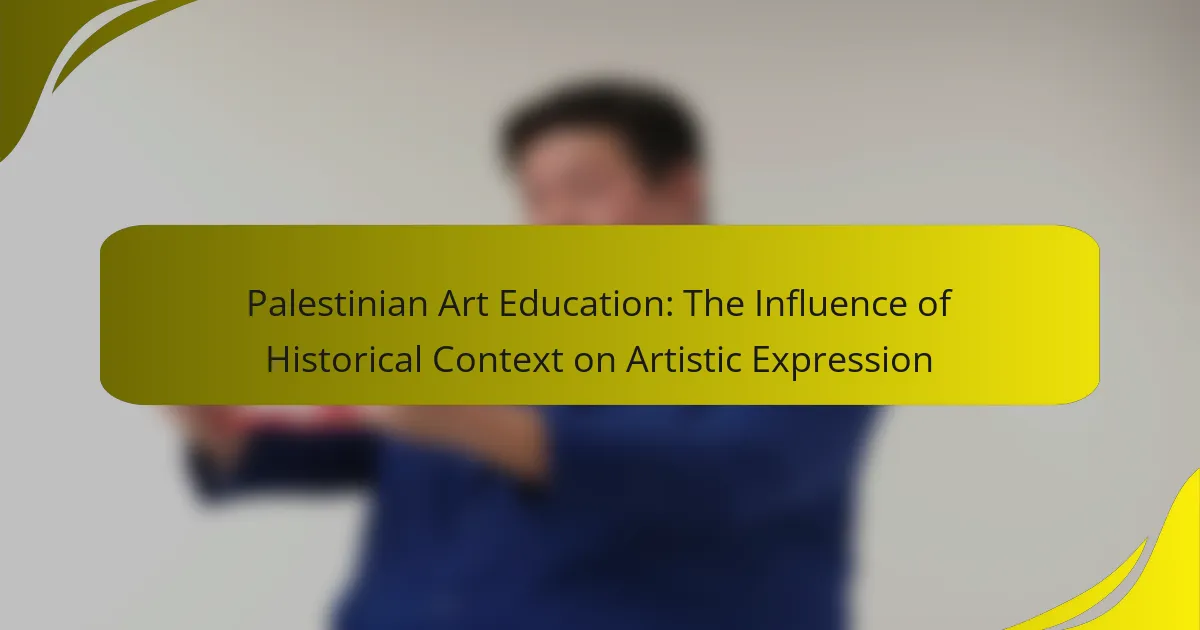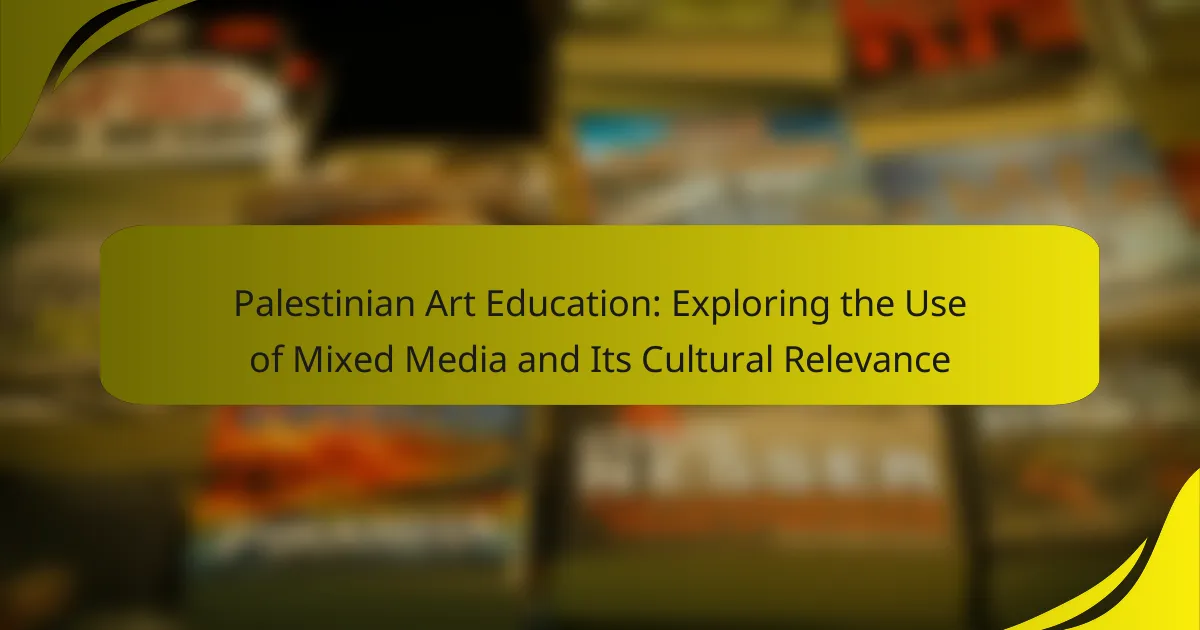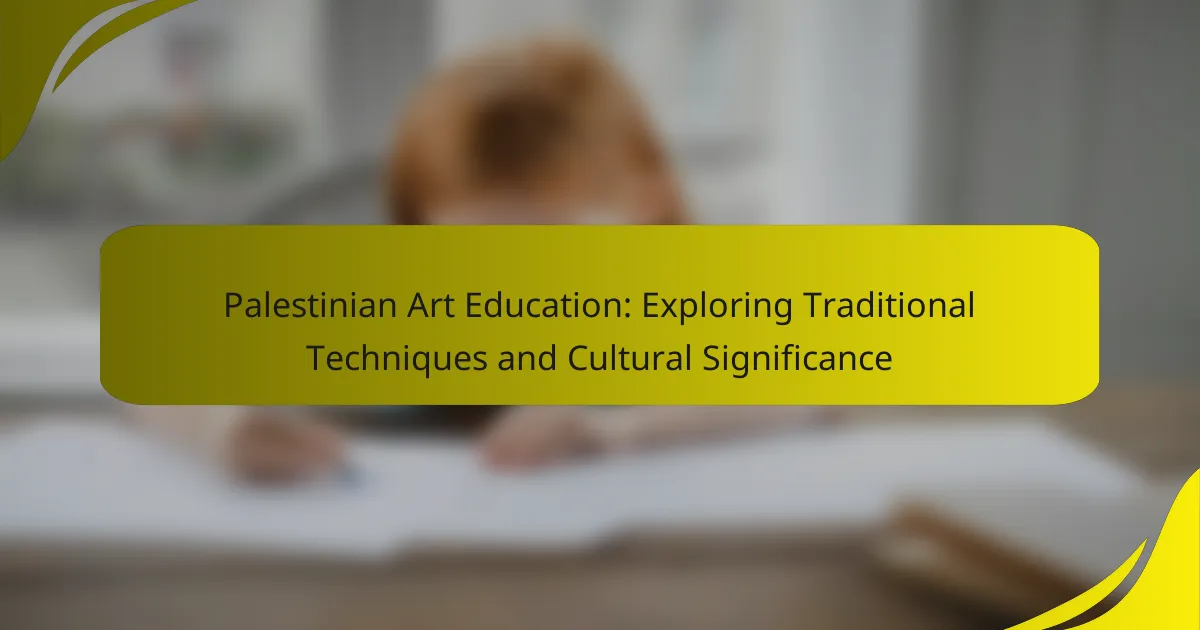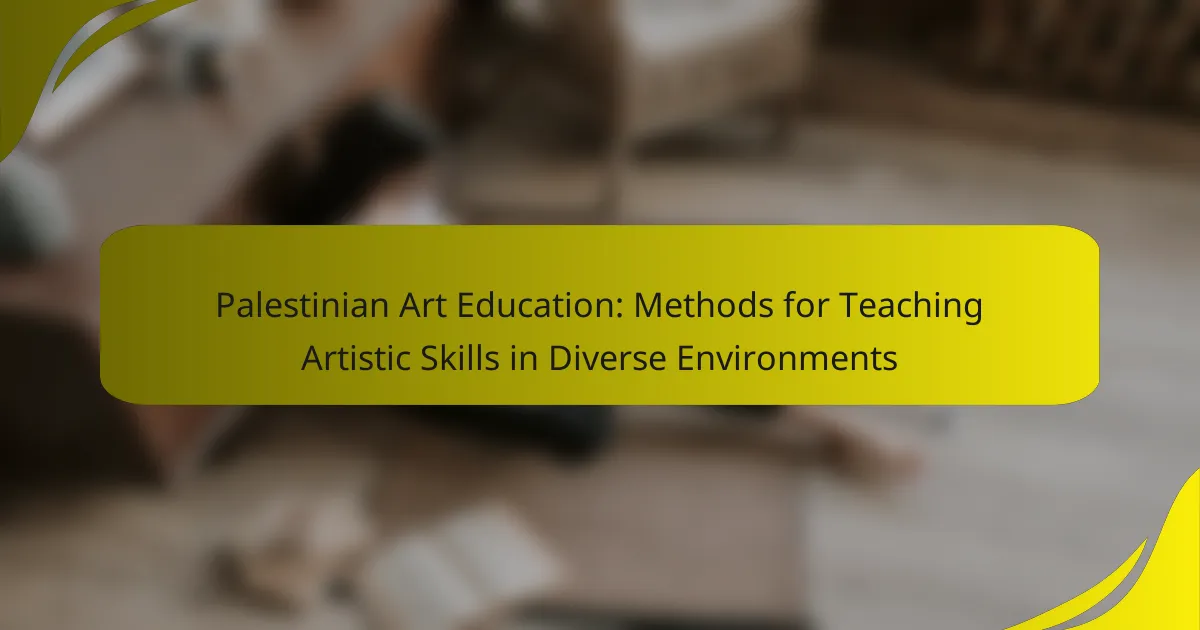Palestinian art education is a vital component of cultural expression and identity formation within Palestinian society. It enables students to articulate their historical experiences and aspirations through various art forms, fostering creativity, critical thinking, and community engagement. This educational approach incorporates local themes and traditional crafts, reinforcing connections to heritage and promoting resilience among learners. Despite facing challenges such as limited resources and political instability, there are opportunities for growth through community initiatives and digital platforms that enhance access to art education. Research highlights the significant role of art education in empowering Palestinian youth and preserving cultural memory.
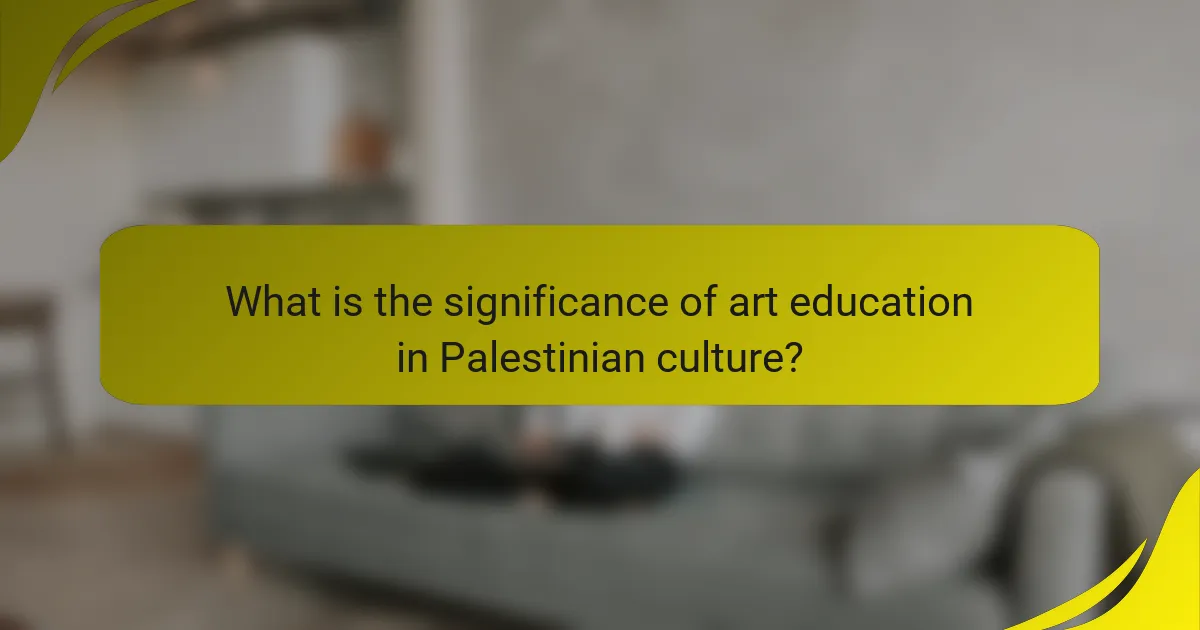
What is the significance of art education in Palestinian culture?
Art education holds significant importance in Palestinian culture. It serves as a means of cultural expression and identity formation. Through art, Palestinians convey their history, struggles, and aspirations. Art education fosters creativity and critical thinking among students. It also promotes community engagement and social cohesion. Furthermore, it helps preserve traditional crafts and narratives. Educational institutions often incorporate local themes into their curricula. This approach enhances students’ connection to their heritage and promotes resilience.
How does art education contribute to the formation of Palestinian identity?
Art education contributes significantly to the formation of Palestinian identity by fostering cultural expression and historical awareness. It enables individuals to explore their heritage through various artistic mediums. This exploration helps in preserving traditional narratives and practices. Furthermore, art education encourages critical thinking and social engagement among students. Engaging with art allows Palestinians to articulate their experiences and aspirations. It also serves as a platform for resistance against cultural erasure. Studies show that art initiatives in Palestinian communities enhance a sense of belonging and solidarity. For instance, programs like the “Palestinian Art Academy” focus on empowering youth through creative expression. This empowers students to connect with their identity and community.
What role does cultural heritage play in shaping artistic expressions?
Cultural heritage significantly influences artistic expressions by providing a foundation of shared values, traditions, and narratives. In Palestinian culture, art reflects historical experiences and collective identity. This connection fosters a sense of belonging and continuity among artists and their communities. Artistic expressions often incorporate symbols and motifs rooted in cultural history. The use of traditional techniques and materials also links contemporary works to ancestral practices. Furthermore, cultural heritage informs the themes and subjects of artworks, addressing social and political issues relevant to the community. Studies have shown that artists draw inspiration from their cultural backgrounds to convey messages of resistance and resilience. Thus, cultural heritage serves as both a source of inspiration and a framework for understanding artistic practices in Palestinian art.
How do historical events influence contemporary Palestinian art education?
Historical events significantly shape contemporary Palestinian art education. The ongoing Israeli-Palestinian conflict has deeply influenced the themes and practices in art. Historical trauma and displacement are central topics in Palestinian art. Educational institutions increasingly focus on these narratives to foster cultural identity. Notable events, such as the Nakba in 1948, are often reflected in artistic expressions. Artists use their work to address issues of resistance and resilience. Additionally, historical events inform curriculum development in art education. This approach aims to connect students with their heritage and collective memory.
What are the primary objectives of Palestinian art education?
The primary objectives of Palestinian art education include fostering cultural identity and self-expression. It aims to empower students through creative skills and artistic techniques. This education promotes critical thinking and encourages social awareness. Additionally, it seeks to preserve and transmit Palestinian heritage and narratives. Art education also provides a platform for dialogue and community engagement. It helps students to reflect on their experiences and challenges. Overall, it plays a vital role in shaping a collective national identity.
How does art education promote social awareness among Palestinian youth?
Art education promotes social awareness among Palestinian youth by fostering critical thinking and expression. It encourages students to explore their identity and cultural heritage. Through various art forms, they learn to articulate their experiences and perspectives. This process helps them understand social issues affecting their community. Engaging in art allows for dialogue about historical and current challenges. It also cultivates empathy and solidarity among peers. Programs often incorporate themes of resistance and resilience, highlighting their societal context. Research indicates that art initiatives enhance civic engagement and activism among participants.
In what ways does art education foster creativity and critical thinking?
Art education fosters creativity and critical thinking by encouraging self-expression and exploration. Students engage in hands-on projects that require innovative problem-solving. This process promotes original thought and unique perspectives. Art education also teaches students to analyze and interpret visual information. This skill translates into critical evaluation of various forms of communication. Research shows that students involved in art education demonstrate higher levels of creativity. A study by the Arts Education Partnership found that students in arts programs scored better in critical thinking assessments. Overall, art education cultivates an environment where creativity and critical thinking thrive.
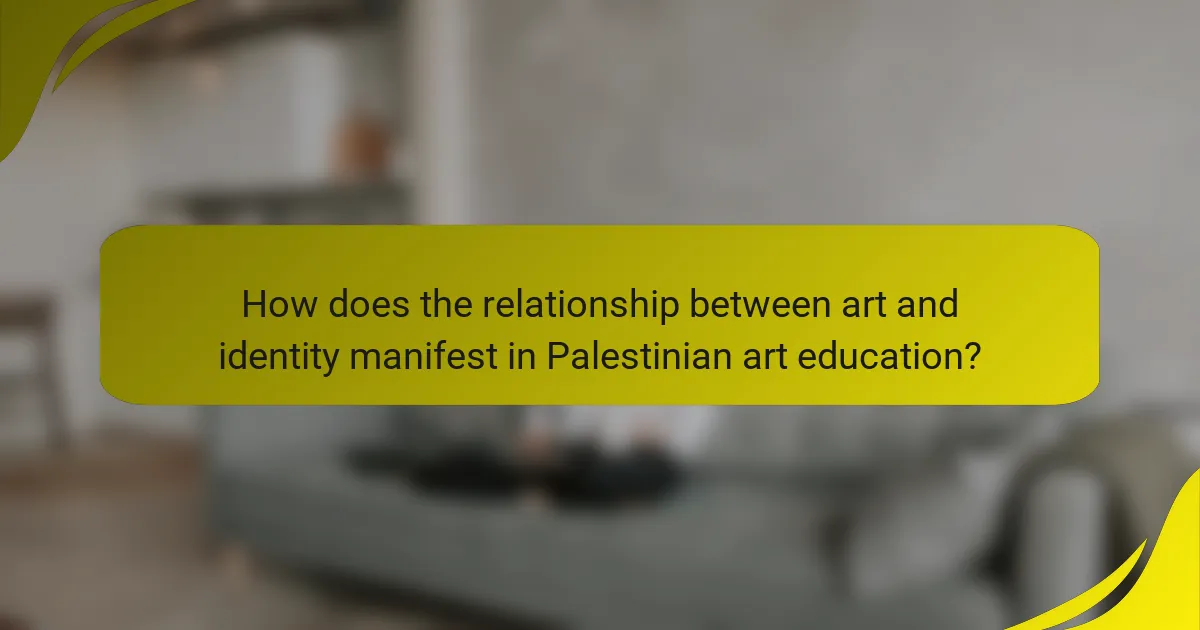
How does the relationship between art and identity manifest in Palestinian art education?
The relationship between art and identity in Palestinian art education is evident in the integration of cultural narratives. Palestinian art education emphasizes the expression of national identity through various art forms. Students learn to convey their historical experiences and cultural heritage in their artwork. This process fosters a sense of belonging and community among learners.
Art serves as a medium for resistance and resilience in the face of adversity. It enables students to articulate their struggles and aspirations. Educational programs often include traditional motifs and themes reflecting Palestinian identity. This approach helps to preserve cultural memory and promote awareness of Palestinian history.
Research indicates that art education plays a crucial role in identity formation among Palestinian youth. A study by Khamis (2020) highlights how artistic expression can empower students and strengthen their cultural identity. This relationship between art and identity is foundational in Palestinian art education.
What themes are prevalent in Palestinian art that reflect cultural identity?
Palestinian art reflects themes of resistance, identity, and heritage. These themes are deeply rooted in the historical and socio-political context of Palestine. Resistance is often depicted through imagery of struggle against occupation. Identity is expressed through symbols of Palestinian culture, such as traditional dress and local landscapes. Heritage is celebrated through the representation of folklore and historical narratives. Artists use these themes to communicate the collective memory of the Palestinian people. The works often evoke emotions related to loss and longing for homeland. This artistic expression serves to unite and empower the community. Thus, Palestinian art becomes a vital medium for cultural preservation and identity affirmation.
How do artists express their identity through various art forms?
Artists express their identity through various art forms by incorporating cultural symbols and personal narratives. They often use visual art, music, and literature to convey their experiences and heritage. For example, Palestinian artists utilize traditional motifs and colors to reflect their cultural roots. They may depict historical events or personal stories that resonate with their community. This approach fosters a sense of belonging and continuity. Additionally, performance art allows artists to engage audiences in conversations about identity and social issues. Research indicates that art serves as a powerful medium for expressing complex identities in conflicted regions. Thus, artists effectively communicate their identities through diverse artistic expressions.
What impact does community engagement have on artistic identity?
Community engagement significantly shapes artistic identity. It fosters a sense of belonging among artists. This connection influences their creative expression and thematic choices. Engaging with the community provides artists with cultural context. It allows them to reflect local narratives in their work. Community feedback can validate or challenge an artist’s perspective. This interaction often leads to collaborative projects that merge diverse viewpoints. Such collaborations enrich the artistic landscape and deepen identity exploration.
How do educators approach teaching art within the context of Palestinian identity?
Educators approach teaching art within the context of Palestinian identity by integrating cultural narratives into the curriculum. They emphasize the historical and social significance of Palestinian art. This includes exploring themes of resistance, heritage, and identity. Educators use local artists’ works as case studies to inspire students. They encourage self-expression through various art forms. Workshops and community projects often enhance engagement with Palestinian culture. Research indicates that this approach fosters a sense of belonging among students. It also promotes critical thinking about identity and culture.
What methodologies are used to integrate cultural narratives into art education?
Methodologies used to integrate cultural narratives into art education include project-based learning, community engagement, and interdisciplinary approaches. Project-based learning allows students to explore cultural themes through hands-on art projects. Community engagement invites local artists and cultural leaders to share their narratives and techniques. Interdisciplinary approaches combine art with history and social studies, providing context for cultural narratives. These methodologies promote critical thinking and personal connection to cultural identity. Research indicates that integrating cultural narratives enhances student engagement and understanding of their heritage. For example, studies show that art education rooted in cultural context leads to deeper appreciation and expression of identity among students.
How do educators address the challenges faced by Palestinian artists?
Educators address the challenges faced by Palestinian artists through curriculum development and community engagement. They create programs that emphasize local culture and history. These programs help artists express their identity and experiences. Educators also provide workshops that enhance artistic skills and techniques. They often collaborate with local artists to foster mentorship opportunities. This collaboration strengthens the artistic community and provides support networks. Additionally, educators advocate for access to resources and platforms for Palestinian artists. They aim to raise awareness about the cultural significance of Palestinian art. By doing so, they help artists gain recognition and visibility in the broader art world.
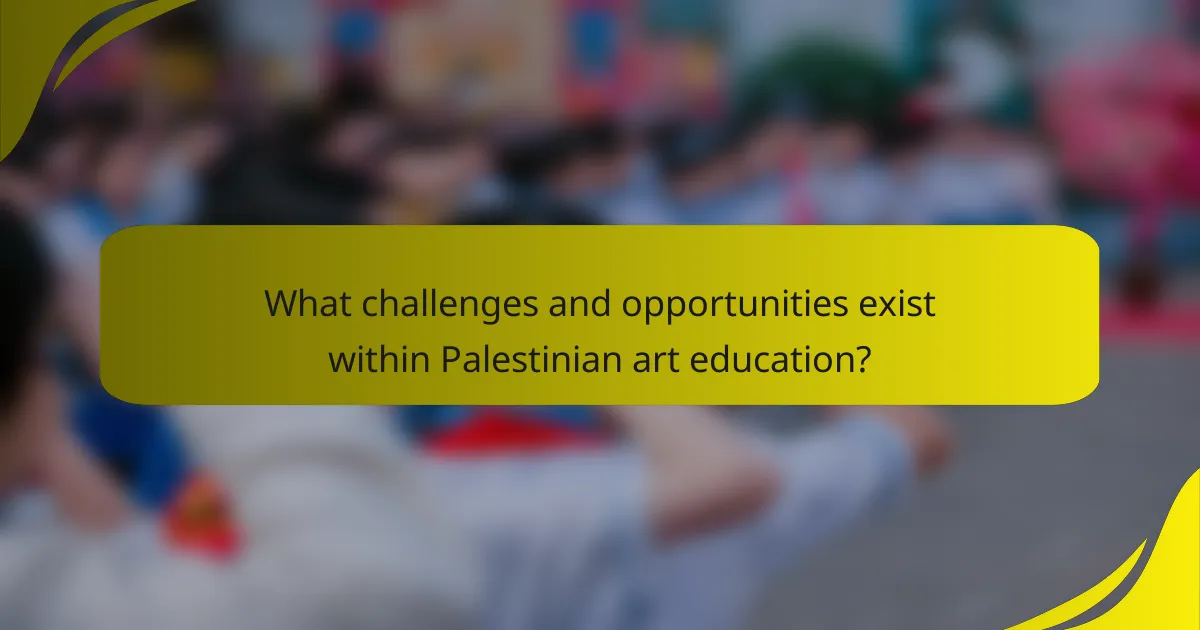
What challenges and opportunities exist within Palestinian art education?
Palestinian art education faces significant challenges and opportunities. Challenges include limited resources, political instability, and restrictions on movement. These factors hinder access to quality art materials and professional training. Additionally, the ongoing conflict impacts the psychological well-being of students and educators. Opportunities exist in the growing interest in cultural expression and identity. Community initiatives and international collaborations can enhance art education programs. Moreover, digital platforms offer new avenues for creativity and outreach. These factors collectively shape the future of Palestinian art education.
What barriers do Palestinian artists encounter in their educational journeys?
Palestinian artists encounter several barriers in their educational journeys. These barriers include restricted access to educational institutions due to political conflict. Many Palestinian territories face limitations on movement, impacting students’ ability to reach schools or universities. Additionally, funding for arts education is often insufficient, limiting resources and opportunities for aspiring artists. Cultural restrictions can also stifle creative expression, affecting the curriculum and available mentorship. Furthermore, the ongoing conflict creates an unstable environment, which can hinder consistent educational progress. According to a report by the United Nations, 80% of Palestinian youth face challenges in accessing quality education. These factors collectively contribute to a challenging landscape for Palestinian artists pursuing their education.
How do political and social factors affect access to art education?
Political and social factors significantly affect access to art education. In regions experiencing conflict, such as Palestine, art education can be severely restricted. Political instability often leads to resource allocation prioritizing basic needs over arts programs. Social attitudes towards art can also influence educational policies. In conservative societies, art may be viewed as less important, limiting funding and support. Moreover, access to facilities and trained educators can be hindered by political barriers. For instance, restrictions on movement can prevent students from attending art classes. Studies indicate that in areas with ongoing conflict, such as Palestine, art education is often marginalized. This results in a lack of opportunities for young artists to develop their skills and express their identities.
What resources are available to support Palestinian art education initiatives?
Various resources support Palestinian art education initiatives. These include funding from international NGOs, which provide grants for art programs. Organizations such as the A.M. Qattan Foundation offer training and workshops for educators and artists. Local community centers often host art classes and exhibitions to promote cultural expression. Educational institutions in Palestine collaborate with global art networks to enhance curricula. Online platforms provide access to digital resources and art tools for remote learning. Additionally, art festivals and cultural events raise awareness and support for local artists. These resources collectively contribute to the development of art education in Palestine.
What future trends can be anticipated in Palestinian art education?
Future trends in Palestinian art education include increased integration of technology and digital media. This shift aims to enhance creative expression and accessibility. Art education programs may also emphasize cultural heritage and identity. This focus aligns with the broader goal of preserving Palestinian narratives. Collaborations with international institutions can provide new resources and perspectives. These partnerships may foster cross-cultural exchanges and workshops. Additionally, community-based art initiatives are likely to grow. Such initiatives empower local artists and engage youth in meaningful ways. Overall, these trends reflect a dynamic evolution in Palestinian art education.
How is technology influencing the teaching and learning of art in Palestine?
Technology is significantly influencing the teaching and learning of art in Palestine. Digital tools are enhancing access to art resources and educational materials. Online platforms allow students to connect with global art communities. Virtual workshops and tutorials provide diverse learning experiences. Technology facilitates collaboration among artists and educators. It also supports the preservation of Palestinian art and culture through digital archiving. The integration of technology in art education fosters creativity and innovation. This shift aligns with global educational trends, adapting to the needs of contemporary learners.
What role do international collaborations play in enhancing Palestinian art education?
International collaborations significantly enhance Palestinian art education by providing access to diverse resources and expertise. These partnerships facilitate knowledge exchange between Palestinian artists and global institutions. Collaborative projects often lead to workshops, exhibitions, and artist residencies that enrich the local art scene. For instance, programs involving international artists foster new techniques and perspectives among Palestinian students. Research indicates that such collaborations can increase visibility for Palestinian art on a global scale. They also promote cultural dialogue, helping to bridge gaps between different artistic communities. Ultimately, international collaborations empower Palestinian artists to explore their identity through enhanced educational opportunities.
What practical tips can enhance the effectiveness of art education in Palestine?
Incorporating community engagement can enhance the effectiveness of art education in Palestine. This involves collaborating with local artists and cultural institutions. Such partnerships can provide students with real-world insights and mentorship opportunities. Additionally, integrating traditional Palestinian art forms into the curriculum can foster a sense of identity. This approach connects students with their cultural heritage. Providing access to diverse materials and techniques can also stimulate creativity. Establishing art clubs or workshops can encourage peer collaboration and skill sharing. Lastly, promoting exhibitions of student work can build confidence and community support.
Palestinian Art Education is a crucial entity that explores the intersection of art and identity within Palestinian culture. This article examines the significance of art education in fostering cultural expression, historical awareness, and community engagement among Palestinians. It discusses how art education contributes to identity formation, preserves cultural heritage, and addresses social issues through various artistic mediums. Additionally, the article highlights the challenges faced by Palestinian artists and educational initiatives, while also identifying future trends and opportunities for growth in art education.
